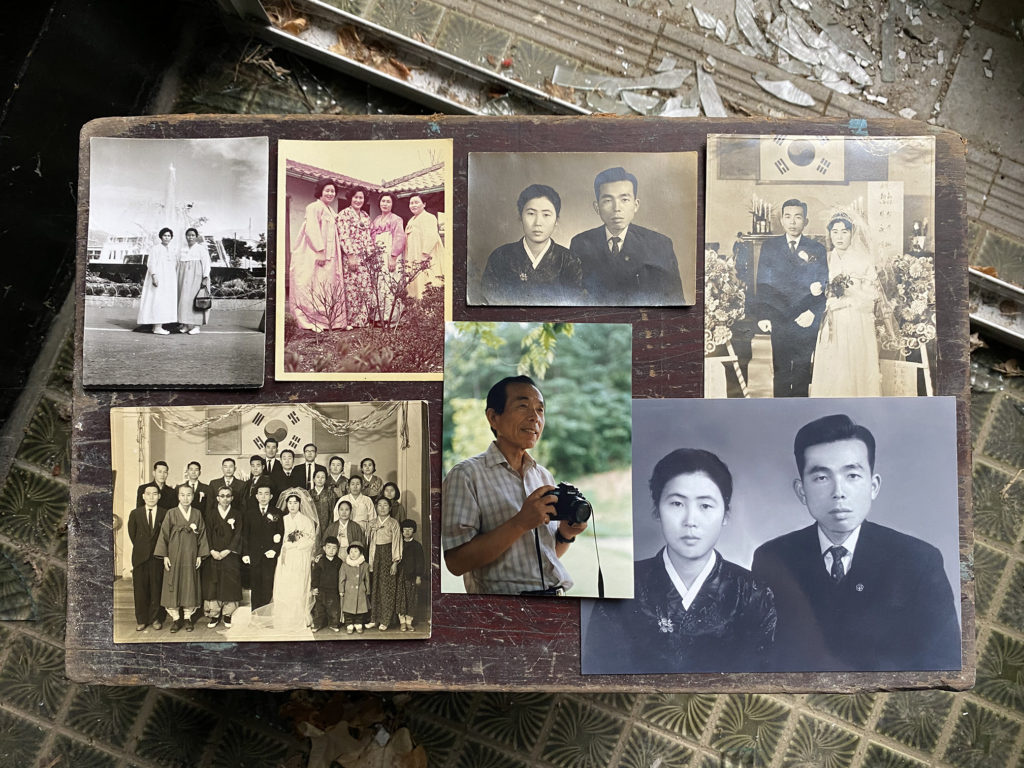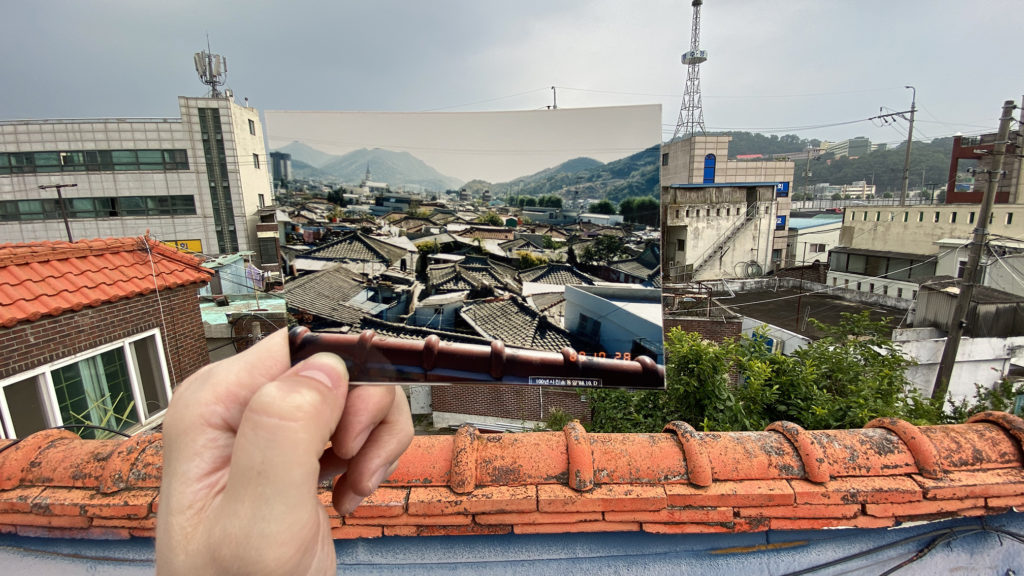Remembering Hak-dong’s Humanity
Written and photographed by Isaiah Winters.
In 1946, on his second and last visit to Gwangju, Korean independence activist Kim Gu paid a special visit to Hak-dong that would leave a lasting impression on both him and the neighborhood. Moved by the grinding poverty he saw there along the Gwangju Stream, Kim donated funds to then Gwangju Mayor Seo Min-ho specifically to relieve the locals’ suffering. With those funds, Hak-dong’s Baekhwa Village with its iconic eight-way intersection was created.[1][2][3] Today, the former impecunity of Baekhwa Village has been utterly transformed through an upscale redevelopment project that’s rendered the neighborhood completely unrecognizable. To commemorate the neighborhood’s lost historical footprint, the Baekbeom Kim Gu Memorial Hall was fortunately created in 2015; however, now with ever more redevelopment afoot, I’ve personally taken a keen interest in the remnants of Hak-dong in the aim that, at the very least, pieces of it may survive online. Written in the interim between eviction and demolition, this article seeks to pay homage to the neighborhood’s enduring humanity by sharing the stories of two of its brilliant residents.
Calligraphy Teacher Kim Yun-hwan
On the second floor of an uninspiring building along Hak-dong Street is an old calligraphy studio that apparently belonged to prolific calligrapher Kim Yun-hwan. To be honest, upon seeing the studio entrance smashed in, I wasn’t expecting to find much inside. From the street, it was clear that Kim had used his windows as advertising space for his studio by papering them over with works of calligraphy, and I figured that alone would be worth checking out. Intrigued, I made my way up the stairs and was stunned to find that everything had been left in place, like it’d just closed up shop a few days before. The centerpiece of Kim’s three-room studio was a tiny classroom arranged in traditional fashion: Students would sit cross-legged facing each other on floor mats and receive instruction from a small table at the head of the class – Kim’s table. With ink sets and brushes still in place, it was as if I’d just walked in on a class at recess. As my imagination raced, I got an eerie feeling that class would resume at any minute and Kim would berate me for not removing my shoes. That eeriness turned to sheer paranoia when I heard the echo of heavy footsteps coming up the stairs behind me.

In these moments of panic, options are limited. One option is to hide and hope not to be seen or slip out somewhere like an alley cat. As I was planted in the middle of Kim’s claustrophobic studio, neither of these options seemed feasible. Another option is to greet the person head-on and politely explain why I’m there – to take pictures and admire the past. Sometimes I even show pictures I’ve taken to disarm the other and deescalate the situation. For whatever reason, this time I decided to instead do something I normally don’t do: Make a bit of noise in the hopes of scaring the other off. Thankfully, on this occasion it worked. Shaken by the near encounter, I hurriedly looked around the studio snapping photos and admiring Kim’s prolific output. A single cabinet had scores of rolled-up hwaseonji (traditional Korean calligraphy paper) brushed by his expert hand – each the height of a man. In addition, every windowpane and wall was covered with his works and photos of him proudly exhibiting them in art studios. In researching this article, I failed to find a single trace of Kim online, which only endeared me more to his purely material collection and inspired me to share his talents digitally before they’re gone forever.
Photojournalist Jo Do-hyeong
Beyond the dark brick walls of an impressive two-story residence is a bedroom storing a local photographer’s prodigious works: thousands of film negatives, half meticulously organized into over forty labeled cubbies and half still scattered about in storage bags. Among the negatives was the photo ID card of Jo Do-hyeong, which identified him as a “photo artist” for CNS Korea’s photo news team. Beneath this, stacks of priceless family heirlooms emerged, including Jo’s wedding photos, his son’s military dog tags, and even photos of Jo himself holding his favorite camera. Most apropos were a few pictures Jo had taken of the surrounding neighborhood from the roof of his home back in 1988. With these in hand, I made a beeline up to the rooftop to compare them to the Hak-dong of 2020. Facing south, only the hills could still be made out in the distance, as Hak-dong and its surroundings have changed so much. Looking north, the expansion of Namgwang Church and a new string of high-rise apartments have obscured Chosun University Hospital, which once towered over the area from a nearby hilltop. It’s serendipitous finds like this that more than make up for all the time lost rummaging through others’ discarded minutiae.

As with the aforementioned calligrapher, I failed to discover anything definitive about Jo online. He’s just one more example of Hak-dong’s many brilliant residents whose purely material remnants are soon to vanish. In a way, there’s something enviable about their lot; they’re part of an ever shrinking cohort with apparently no digital footprint – the last of the “analog humans,” as it were. While researching for this article, I luckily stumbled upon a recent article from Women’s Comprehensive News about how the director of Gwangju’s East District, Im Taek, has just signed a business agreement with the housing cooperative in charge of Hak-dong’s current redevelopment. His aim is to preserve the fading memory of Hak-dong’s fourth zone (the one featured here) by collecting photos and stories of local residents and significant places in the neighborhood. Roughly translated, Im stated, “It’s a pity that so much human capital retaining the history and identity of the area is in danger of disappearing due to the redevelopment and maintenance project in the old town … I’ll try to make its remembrance possible.”[4] Sharing his sentiment, I hope this humble article and the images I’ve collected carry the works of Kim and Jo over into the digital world where they can be appreciated forever.

Sources
[1] Jeong, D. (2014, October 01). 광주 학동에 ‘백범 김구 기념관’ 세운다.Hankyoreh. http://www.hani.co.kr/arti/area/area_general/657873.html
[2] Jang S. M. (2020, April 27). 백범의 숨결 스민 광주 ‘백화마을.’ Gwangju Ilbo. http://www.kwangju.co.kr/article.php?aid=1587913200694422131
[3] Ernesto (2018, December 10). 역사 교사인 나도 몰랐다, 광주백범기념관. OhmyNews. http://www.ohmynews.com/NWS_Web/View/at_pg.aspx?CNTN_CD=A0002494645
[4] Lee, G. (2020, May 24). 광주광역시 동구, 주택재개발조합과 마을인문자산 보존 ‘맞손.’ 여성종합뉴스. http://womannews.net/detail.php?number=226701
THE AUTHOR
Originally from Southern California, Isaiah Winters is a Gwangju-based urban explorer who enjoys writing about the City of Light’s lesser-known quarters. When he’s not roaming the streets and writing about his experiences, he’s usually working or fulfilling his duties as the Gwangju News’ heavily caffeinated chief proofreader.







